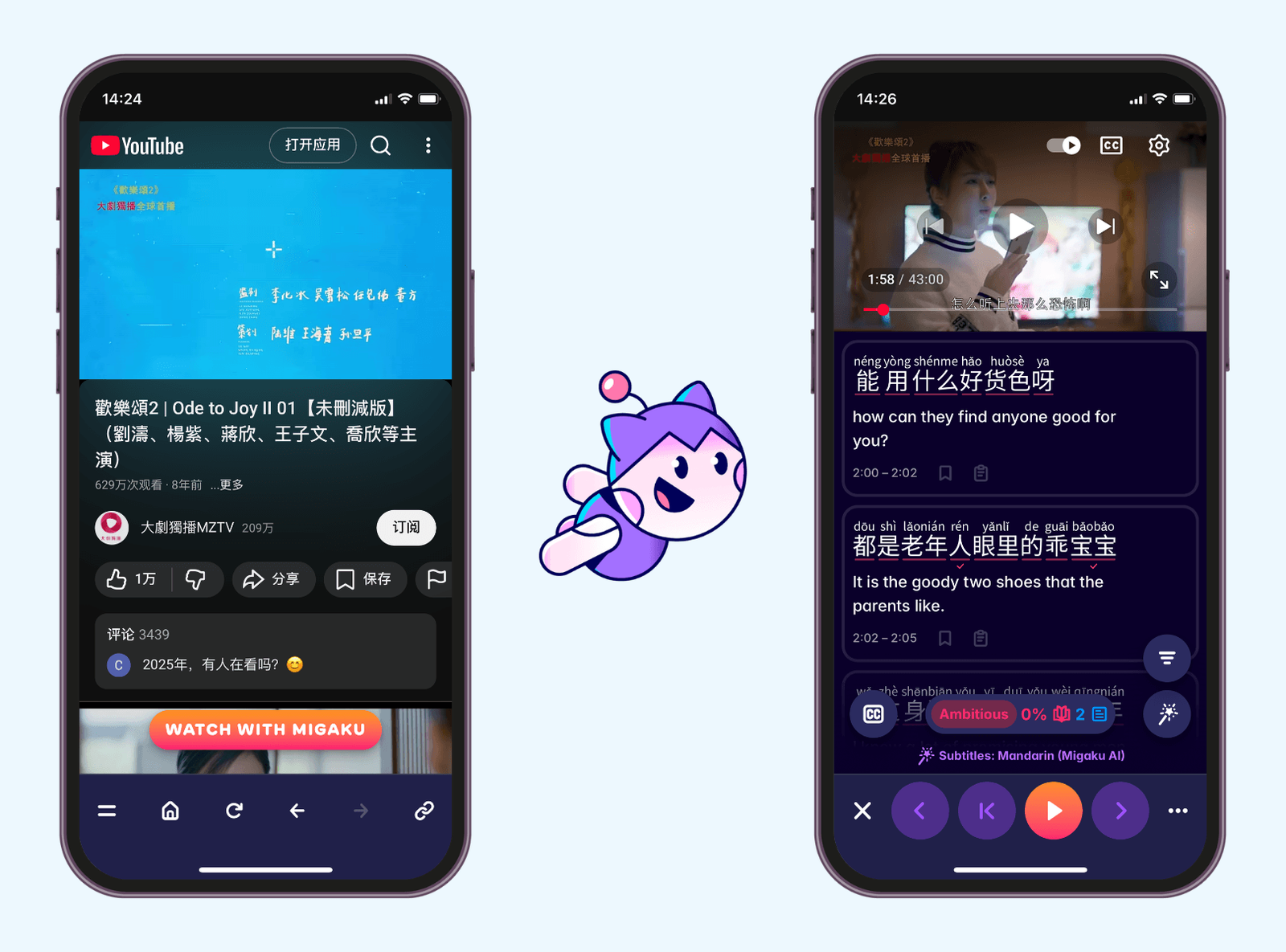Three Best Chinese Tone Practices: Master Chinese Tones with Tone Pairs Collection and Shadowing
Last updated: November 25, 2025

Tired of your Chinese friends' confused look? Don't be too harsh on yourself! As a Chinese learner, you won't be the first one, or the last one, to say "" (I want to kiss you), but actually meaning "" (I want to ask)... Chinese Mandarin is a tricky language where the meaning and character will be altered with the change of tones! This guide is your fun, no-fuss ticket to tone mastery. We’ll break down the five core tones, share genius practice tricks, and have you speaking with clarity and confidence.
Meet the Chinese tone family: the four tones and the neutral tone
Ready to learn the five tones that give Chinese its musical charm? Think of them as a lively family, each with a unique personality. We have four energetic core members and one easy-going cousin. Getting to know them individually is your first step to holding a clear conversation. Understanding their distinct sounds will turn confusing mumbles into meaningful words
- The first tone (¯): A high, steady, and flat pitch. Like singing a high note or the sound of a siren.
Example: 。 (My brother is moving home with his backpack.) - The second tone (´): A rising pitch that starts medium and goes up, like you're asking "What?!" in English.
Example: (My uncle asked me to extract the tooth at the dentist.) - The third tone (ˇ): A falling-then-rising contour. It starts mid, dips low, and then rises. In rapid speech, it often only dips and doesn't fully rise.
Example: (I'd like to have five bowls of bitter melon noodles.) - The fourth tone (`): A sharp, strong fall from a high pitch to a low one. Like a command: "Stop!"
Example: (I went to watch movies.) - The neutral tone: A light, short, and unstressed tone with no fixed contour. Its pitch is influenced by the preceding tone.
Example: (Sorry to trouble you.)
Practice 1: isolated syllable drills
The first practice is for beginners who have just started to learn how to pronounce pinyin tones in Mandarin Chinese. The priority of this stage is to memorize the five tones and get yourself familiar with what these five tones sound like when they are applied to characters and phrases.
Don't overlook this simple practice, especially if your native language does not have strict tone rules on pronunciation. It is rather difficult to memorize the tone of each character and properly pronounce these tones in the beginning!
- Practice the same sound with different tones: For example, when learning Mandarin tones and syllables, learners can pick some syllables and practice the four tones of those syllables, like yī, yí, yǐ, yì.
- Practice different sounds with the same tone: This practice can help you get used to what different syllables sound like with the same tone, and get to know what a specific tone should sound like, such as mā, tā, bā, fā (all first tone).
Practice 2: tone pairs collection
Mastering individual tones is just the beginning. In fluent speech, tones connect and influence each other, creating predictable patterns called tone pairs. This is the bridge from slow, isolated words to natural conversation.
In Chinese, there are many tone change combinations, and it is impossible to exhaust the combinations in this post. That's why you should collect these combinations in a notebook and accumulate them over time!
Here are the rules and examples for the third tone sandhi that beginners can collect and learn:
- When two third tones meet, the first one politely changes to a second tone.
Examples: - (Hello). - When three third tones meet, if the first two characters form a meaningful pair, the first two characters should be changed to the second tones.
Examples: - (Bath water). In this case, both and are of the third tone, and they can be combined into a meaningful pair, (Bathing), so both of them are changed into the second tone. - When three third tones meet, if the last two characters form a meaningful pair, the second character should be changed to the second tone.
Examples: - (Use the umbrella). Different from , in this case, (Umbrella) forms a meaningful pair, so the second character is changed to the second tone.
Some other tone changes of Chinese characters are closely related to their changes of meanings and word class in different contexts, such as (Backpack) vs. (Behind someone's back), (Change) vs. (Even more), (Boat rowing) vs. (Plan).
Practice 3: shadowing and mimicry
Shadowing is the powerful practice of listening to a native speaker and repeating what they say in near real-time, like an echo. The sore spot for many Chinese learners when it comes to tones is how to put characters with different tones together and say sentences with their natural flow.
This technique moves you beyond theoretical knowledge and trains your mouth and ears simultaneously. The goal is not to analyze the grammar or translate the words, but to purely focus on the music of the language—the rhythm, the cadence, and, most importantly, the flow of the tones. This practice should be performed together with the second practice. This combination will be more efficient as learners are building up their lexicon and tone-change collection.
Shadowing should be practiced with several key steps:
- Mark the pinyin of each character with its tone. You can go through the dictionary to complete this step.
- Try to read the material out loud, and get yourself familiar with the text.
- Listen to the audio, and repeat each sentence to correct your pronunciation.
- Shadow the audio without pausing at each sentence.
For effective practice, you need a solid material pool!
There are many options on the Internet for learners to explore the materials for lexicon collection and shadowing. Yet, wouldn't it be nice to have a one-stop solution? - A platform with videos, audios, subtitles, pinyin, dictionaries, and a pause-play function. The Migaku app provides Chinese learners with such a simple solution that they can not only access YouTube as a pool for materials, but also use Migaku to play, pause, and look up pinyin syllables with tones for each character!
For example, if you'd like to try shadowing with Migaku, you can:
- Open the Migaku app and choose YouTube
- Search up a Chinese video and click "Watch with Migaku."
- Tap the magic wand in the lower right corner to generate subtitles
- There you go. Now, you can shadow the video with the help of subtitles and their pinyin!

Practice Mandarin Chinese tones today, and you will master it eventually
And that's a wrap! You're now armed with the secrets to practice Chinese tones. Remember, every expert was once a beginner.
If you consume media in Chinese, and you understand at least some of the messages and sentences within that media, you will make progress. Period.
Stop struggling and start speaking—your tonal triumph begins now!